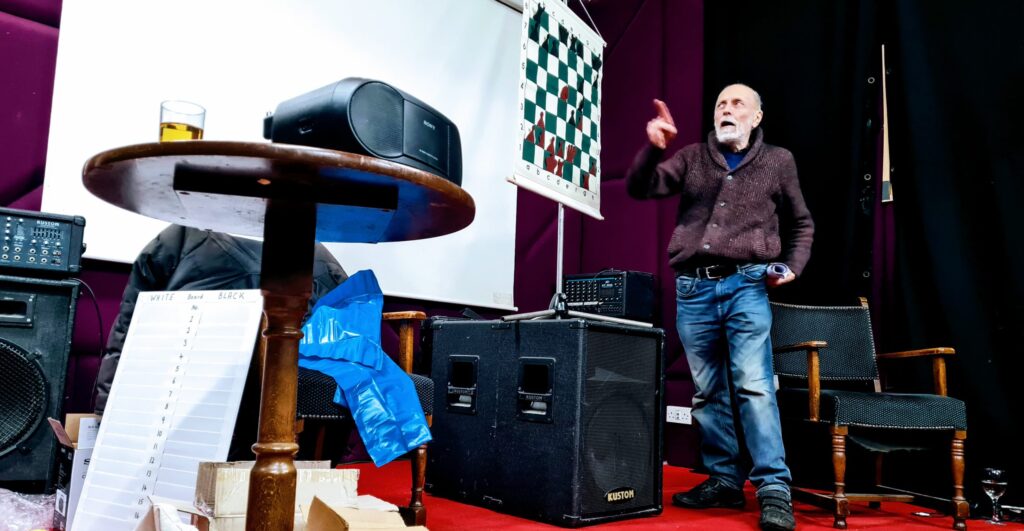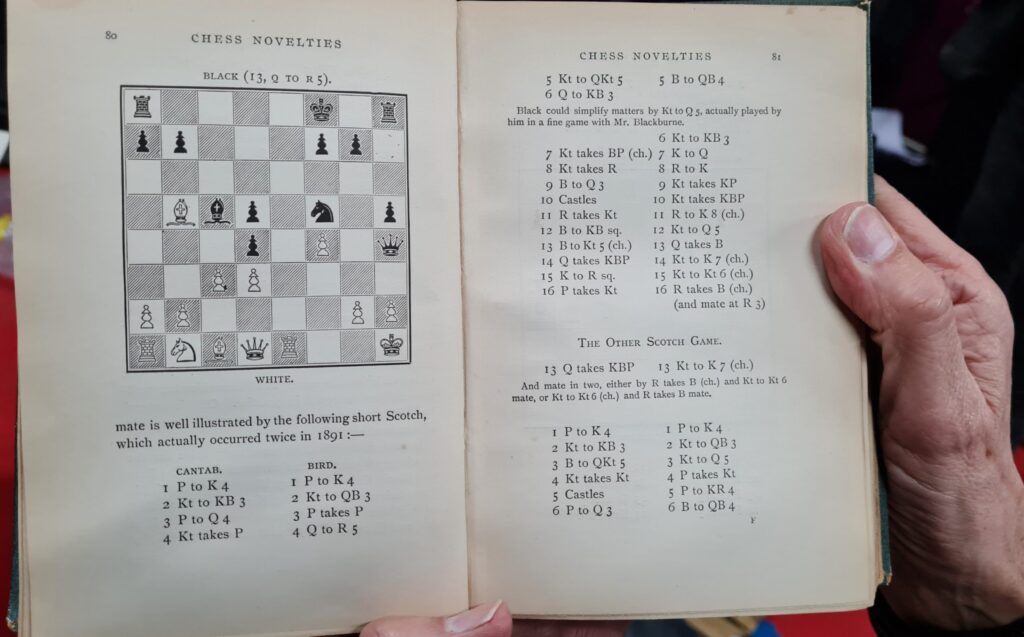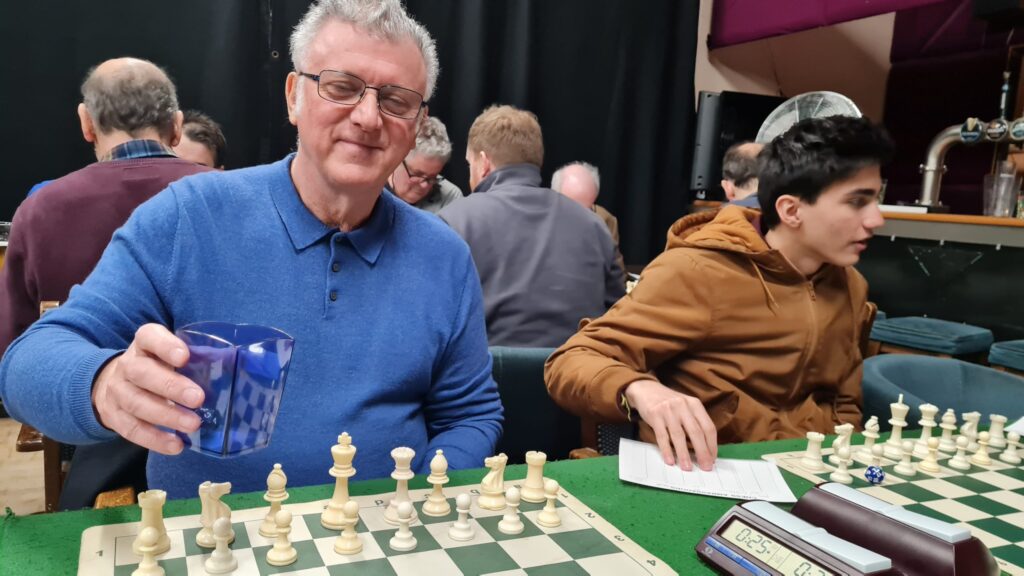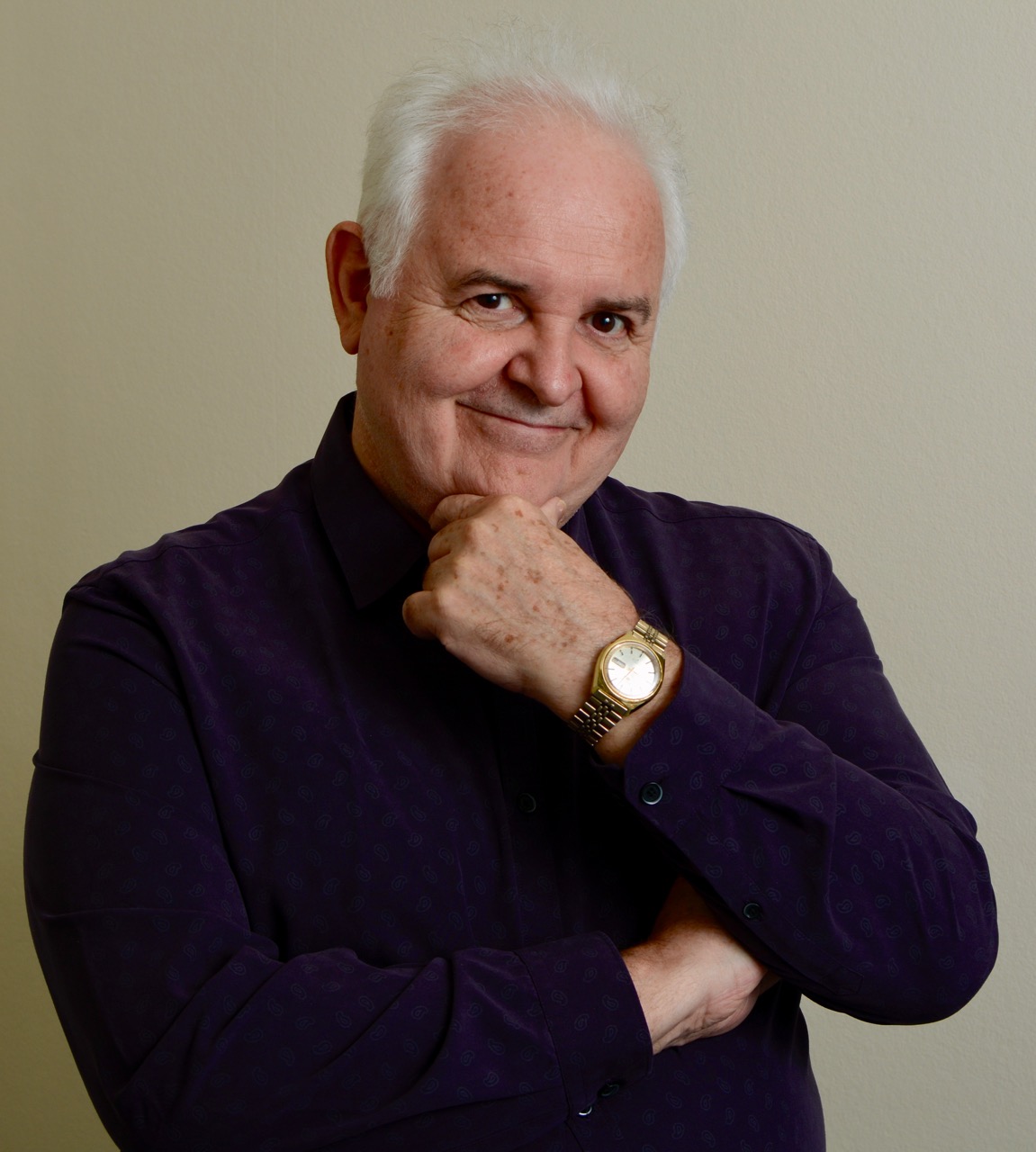Legendary IM Michael Basman gave a presentation on the games and legacy of H.E. Bird
Michael Basman treated us last night, the evening of St Valentine’s, to a lecture – more of a love note – to Henry Bird, one of the historic figures of English chess. Although primarily known as an openings innovator and chess instructor, notable for having founded the UK Chess Challenge, Basman has a keen interest in chess history, as befits a chess player who studied history at university.
The topic of the talk was unknown in advance to the assembled Kingstonian cognoscenti. We half expected a detailed analysis of some games in which Basman had narrowly failed to beat the Soviet legends Tal and Botvinnik back in the late 1960s/early 70s when Basman played for England. Perhaps we could have been treated to a discourse on the Fried Liver Attack which Basman had popularised in his early instructional pamphlets, having translated the term from the somewhat more stylish word Fegatello, an Italian dish. Instead, we were given a thoughtful and masterly account of the evolution of international chess in the Victorian period.
Basman devises his lectures as he devises his openings – with an element of surprise. We never know what we are going to get until it happens. There are, however, some constants. First of all, Basman is an excellent verbal communicator. He speaks fluently and authoritatively with an irrepressible wit. Given the subject matter, avian puns were unavoidable, in this case mainly from the audience sadly. Secondly, pure thought must be unadorned by technology. So the presentation notes were handwritten on loose sheets of A4 paper. The absence of staples meant that at one point the sheets inevitably got mixed up. Suddenly we had a vision of a hapless prime minister making a disjointed speech to the Confederation of British Industry. Fortunately, our speaker retrieved the situation without having to resort to ruminations on Peppa Pig.

I recall a presentation Basman gave at the London Chess Conference in 2016. The topic was “A survival guide to teaching chess”. I had expected stories of teaching chess in the classroom or of setting up a national schools chess tournament or even an academic account of chess didactics. Instead, we were given a financial survival guide based on Basman’s well-publicised dispute with Her Majesty’s Revenue and Customs regarding the application of VAT. Suffice to say that a pedagogue representing himself was no match for Queen’s Counsel, resulting eventually in the loss of the case and a financial disaster. Instead of Powerpoint slides, the presentation used large colourful posters held aloft by an attractive assistant. This episode was surreal to say the least. The attendees said later that they had no idea about tax law but that it had been very amusing.
Henry Edward Bird was born in Portsmouth in 1830 (or 1829 according to other sources) in a period when chess in England was in its infancy. Bird was to prove crucial in popularising chess and played a vital part in the development of the game during the 19th century. He was a railways accountant and wrote a book on the subject. The coming of the railways was fundamental to social and cultural change. Indeed, we can trace the emergence of chess in English towns to the arrival of the railways. So in his profession, Bird literally carried chess to the population (see also the Kingston railway connection).
According to Basman, Bird should be much better known. He attributes Bird’s relative obscurity to losing out to Howard Staunton (b. 1810) in what we would today call the information war. When chess history comes to be rewritten, Bird will earn his rightful place in the pantheon of masters.
One cannot help but surmise that the reason for the choice of topic is that there are biographical parallels between the lives of Basman and Bird. Both are notable chess players who arguably did not get the recognition they deserved. They are both openings innovators. Bird lends his name to Bird’s Opening (1. f4) and the Bird’s Defence in the Ruy Lopez. Basman has popularised offbeat openings (Grob, St George Defence) and his name is attached to various other openings (eg Basman-Williams attack against the King’s Indian). Bird and Basman were also both popularisers of the game. Bird had a vision of the newly emerged industrial working classes adopting chess and wrote several chess books, as has Basman.
We learned that Bird did not particularly favour the Bird’s opening. This leads us to the main takeaway from the evening: our openings repertoire is too narrow. Bird liked to try many different openings, including 1. g4 and 1. h4. His contemporaries were unsettled by this unpredictability, which was his main purpose. Eventually, 30 years after he started playing it more regularly, the Bird’s opening was credited to him in 1885.
Bird was of the romantic school of chess and relished sacrifices and attacking play. He played all the greats, including Horwitz, Anderssen, Falkbeer, Boden, Blackburne, Gossip, Mason, Macdonnell and Winawer. He played Morphy on the latter’s trip to England in 1858. Bird witnessed the rise of Steinitz and the scientific “accumulation of small advantages” school which went on to dominate chess strategy.
Bird had clear opinions on his chess contemporaries and the chess scene. He was playing before the invention of chess clocks and analysed the prospective introduction of chess time controls. He categorised players according to the time control at which they best performed. The comparison was measured in moves per hour. He warned against slow time controls as this would take chess out of the reach of the casual chess player and the working man. He recommended that around two hours was a suitable length for a game. This was a prescient observation given the rise of rapid and blitz chess in modern times. His views are completely in line with leading players of the present day. When I discussed this topic with Alexei Shirov, he told me that he wants two hours tops for a game, if only to minimise the chance of cheating.
Basman went on to look at some of Bird’s games from his book Chess Novelties and Their Latest Developments published in 1895. He handed out for inspection a first edition of this book, which had previously been in the possession of G.H. Diggle (1902-93), the eminent historian of chess in the 19th century.

One of the games we looked at was Cantab v Bird 1891, a casual game played against somebody presumably associated with Cambridge University. It illustrates Bird’s aggressive style of all-out attack. The text uses an older form of descriptive notation which is still a pleasure to read due to its spaciousness and verbally guided placement of the pieces.
Following the talk, Basman organised a unique rapidplay Bird tournament. It comprised a one-round Swiss complete with pairing cards. The uniqueness lay in the selection of opening moves. In the spirit of Bird, and fellow traveller Basman, the players were bound to play a wider variety of openings. Basman noted that there are 20 moves available on the first move for each player. He therefore obligingly brought along isocahedral (ie 20-sided) dice, which each player rolled to randomise their first moves.

The idea of randomising the opening moves stems from the feeling that chess has been extensively analysed and that some changes are required to bring creativity back into the game. An alternative method, Neoclassical Chess, developed by Gabriel F. Bobadilla from Spain, involves randomising the first three full moves. Randomising the opening moves may make some people uncomfortable, but the main alternative approach is Fischer Random, which has the downside that the starting position is different.
Having rolled the die, we consulted the table of moves, inevitably called a Bird Table, corresponding to the number on the die. The Bird Tournament passed off in good spirit. Basman’s win on top board against Peter Lalić was offset by Pat Armstrong’s win for the opposing team on bottom board against Mehran Moini, who hasn’t touched a pawn in 40 years. “I thought we were playing for the same side?” said a bemused Basman to Armstrong when the results were totted up. All were happy at the end of the evening. Thereafter, it was down to the bar to play blitz.
John Foley
Stephen Moss writes: Michael Basman died just nine months after giving this memorable talk and devising a wonderful evening of Basmaniacal chess. He must already have been ill with the cancer that was to kill him, and this will have been one of his last public events, though he also presided over an evening of highly competitive blitz at Chessington Chess Club to celebrate the club’s first birthday a few months later when he was visibly declining but still full of humour and love for chess. He produced a short book on Bird based on his talk and on the games played at Kingston that night – his last chess book.
